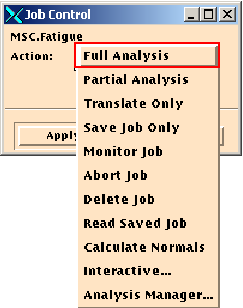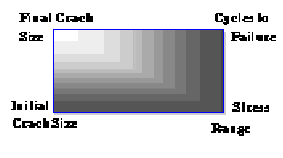XXXXXXXXXXXXXXXXXXXXXXXXXXXXXXXXXXXXXXXXXXXXXXXXXXXXXXXXXXXXXXXXXXXXXXXXXXXXXXXXXXXXXXXXXXXXXXXXXXXXXXXXXXXXXXXXXXXXXXXXXXXXXXXXXXXXXXXXXXXXXXXXXXXXXXXX''"> Run the Fracture Analysis
You are ready to run the fracture analysis. Open the Job Control... form, set the Action to Full Analysis and click the Apply button. The database will close momentarily as the results information is extracted. When the database reopens, the job will have been submitted. You can then set the Action to Monitor Job and click the Apply button from time to time to view the progress of the crack growth. When the message appears, the analysis is complete. Close down the Job Control... form when done.
Crack growth calculation completed successfully
Cycle by Cycle Growth
The only accurate way of predicting crack growth is by adopting the cycle-by-cycle approach. Normal rainflow cycle procedures are used in Crack Growth analysis as with the other two methods, however the cycles are reordered into their original sequence to retain the sequence effects. For each cycle the crack extension, da, is calculated and added to the current crack size and this process continues until a failure condition is reached.
The driving force for propagation due to each cycle is the range of stress intensity, ΔK. For each cycle the apparent or applied driving force is calculated from the stress range, current crack size, and geometry (compliance function) of the component. It is then modified due to various considerations of crack closure, history or overload effects, notch and environmental influences, and static fracture mode contributions. The modified (effective) ΔK is then used to determine crack extension for any given cycle using material parameters and the Paris Equation.
Note: | It should be clearly understood that even though the growth of microscopic cracks is governed by linear elastic fracture mechanics, the microscopic crack extension process by fatigue still necessitates local plasticity. At the tip of a fatigue crack there is a plastic zone. The crack tip plastic zone is assumed to be negligibly small in relation to crack size, especially for high strength materials, but essential to the fatigue crack growth process. |
The Fatigue Crack Propagation Rectangle
As discussed earlier, the Fracture Mechanics Triangle relates stress intensity, stress, and crack length. When speaking in terms of crack growth and overall life, a rectangular rather than a triangular representation is used. In Crack Growth there is a relationship between stress range and life just as with the Total Life (S-N) method except it is extended to include the initial and final crack lengths (and all crack sizes in-between these two limits). So in a similar way to solving the triangle, the fatigue crack propagation rectangle can be solved by knowing any three of the four corners to derive the fourth.


